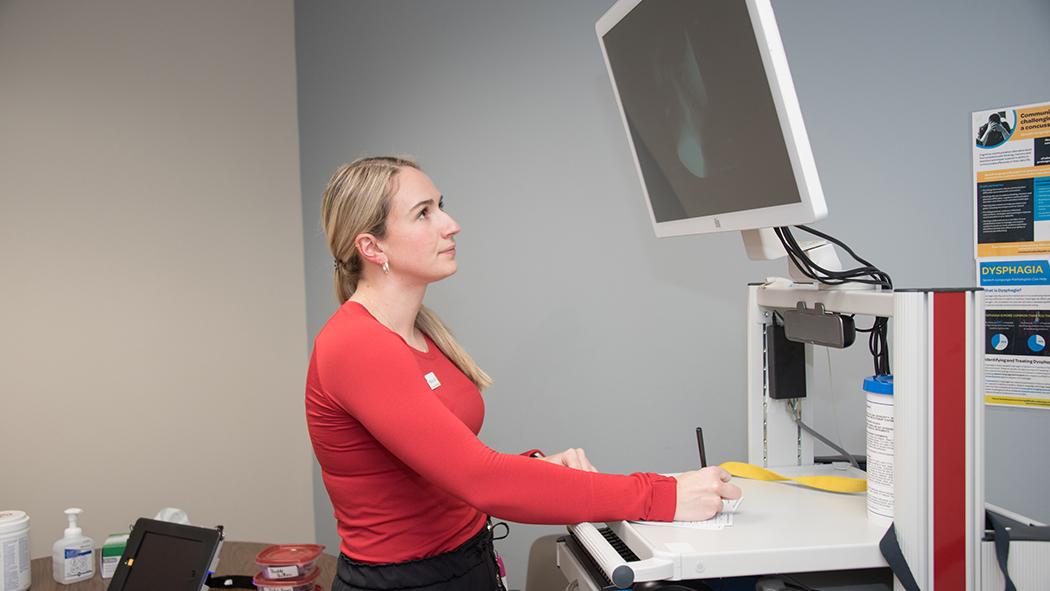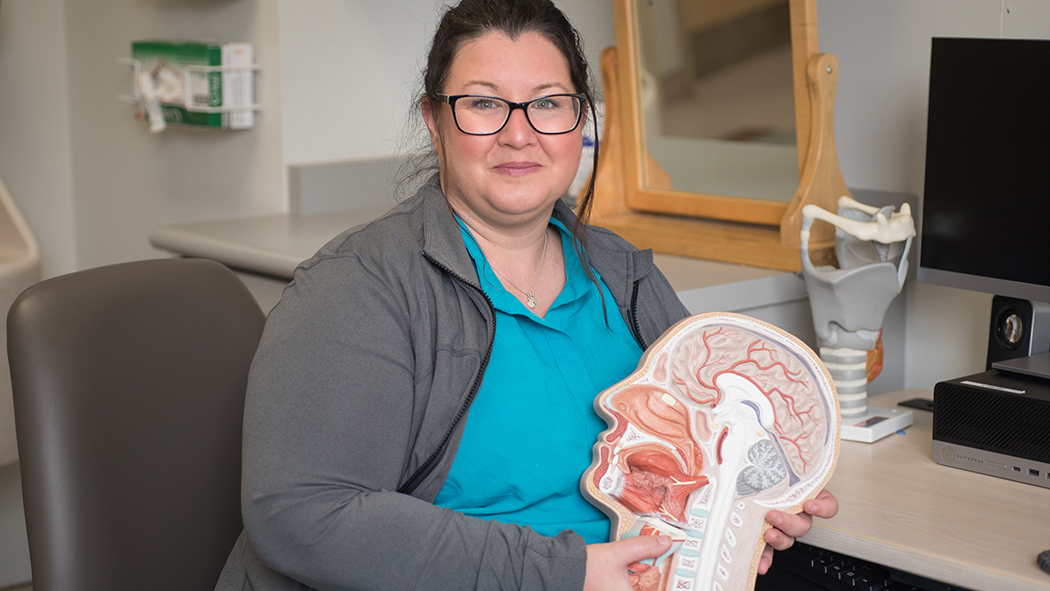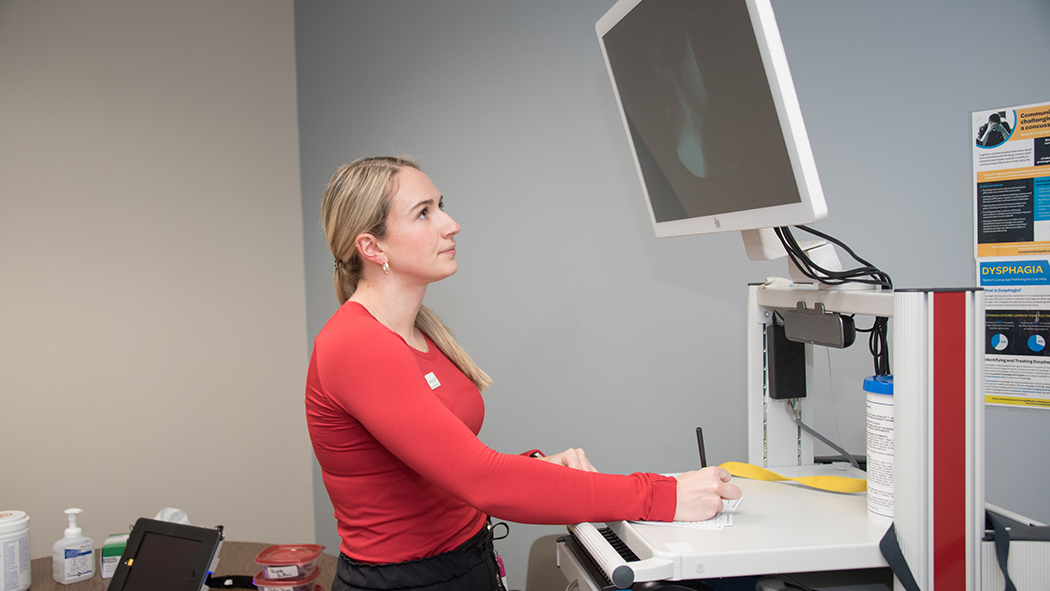
May 17, 2023
Previously, we learned how speech language pathologists (S-LP) at London Health Sciences Centre (LHSC), assess and manage patients swallowing and communication functions.
There are specialty areas within LHSC that S-LPs support, two examples are Clinical Neurosciences (CNS) and Head and Neck Cancer.
Kendra Thouless, Speech Language Pathologist – Head and Neck Cancer
S-LPs in Head and Neck Cancer at LHSC primarily work with patients who are having surgery or radiation treatment for head and neck cancers. Kendra assesses the swallowing and communication functions of patients before they start treatment, and then monitor their speech, communication functions, swallowing and help manage side effects from the treatment and provide rehabilitative treatments as needed. These patients are seen in conjunction with an otolaryngologist or radiation oncologist.
Kendra also works with patients who have had a total laryngectomy – the removal of the voice box.
“We provide education to the patient and help them manage their communication needs after the removal of their voice box,” explains Kendra. “Patients need a new way to communicate after this surgery such as with a tracheoesophageal prosthesis (TEP) – which is a silicone prosthesis that helps people talk. And an electrolarynx, which is a battery-powered device.”
Patients who have had a total laryngectomy breathe out of a hole in their neck which does not provide the same ability to moisten or warm air that goes into the lungs as through the nose and mouth. S-LP’s help implement head and moisture exchange systems to help patients who need to breathe in a new way.
“Breathing, talking and swallowing are all key things for people and when any one of these functions change, it is life altering for patients,” explains Kendra. “When these functions aren’t working, it is very hard for people which is what makes this work simultaneously powerful and challenging.”
Another therapy S-LPs in Head and Neck Cancer provide is voice therapy, which is for those who have had surgery on the voice box. This surgery results in changes in a person’s voice.
S-LPs in this area also help patients after surgery and after experiencing side effects to radiation treatments. Head and Neck Cancer patients have unique needs because of the intricate nature of the functions of the muscles used for speech and swallowing and how cancer treatment affects these muscles.
“The tissues and muscles are intricate and perform very specialized jobs such as how you voice, how you eat, and damage to those muscles can lead to long term side effects,” Kendra says. “The surgery for these types of cancers is also very specialized. The surgeon may remove parts of the tongue, jaw or mouth and then, usually, another piece of tissue is put in to place it. We have to teach patients how to work with the new tissue in their mouth and new anatomy.”
Kendra enjoys having the opportunity to follow patients through their entire cancer journey from pre-treatment to recovery and survivorship. “Seeing a patient throughout their health care experience helps me build a relationship with them,” Kendra says. “It’s so rewarding to see patients get back to their life and their new normal.”
Kendra works as part of an interdisciplinary team within the Head and Neck Cancer department. The team she works alongside performs interdisciplinary rounds each week to ensure consistent and patient-centred care. Some of the other disciplines she works with include other health discipline professionals (such as physiotherapists, dietitians and social workers), radiation oncologists, medical oncologists, radiation technologists, surgeons, among others.
Alicia Bergen, Speech Language Pathologist – Clinical Neurosciences
The role of an S-LP in Clinical Neurosciences (CNS) largely consists of helping patients who have acquired communication or swallowing impairments from neurological damage (e.g., from a stroke or brain tumour).
“Our brains control both speech and swallowing processes, so on the CNS floor we often get patients with needs for both functions,” Alicia says.
For communication impairments, S-LPs see patients with neurological damage, those that have a change in voice, motor speech difficulties, cognitive communication changes, aphasia, and fluency disorders.
“Motor speech is a broad term that encompasses motor planning and control of the respiratory and articulatory systems used during speech – the ability to move your mouth, tongue and lips and be able to make vocal sounds,” Alicia explains. “Cognitive communication changes refer to the thinking processes required to interact meaningfully with one another. Aphasia is a term meaning ‘impaired language’, and it often leaves people unable to communicate effectively with others.”
CNS works with both inpatients and outpatients and there are three inpatient service areas – stroke, neurosurgery (e.g., for brain tumours and brain hemorrhages), and general neurology. The general neurology area works with patients who have a wide range of neurological conditions including Parkinson’s disease, multiple sclerosis (MS), and amyotrophic lateral sclerosis (ALS). There is also an outpatient clinic for ALS and movement disorders such as Parkinson’s.
There are unique needs for those experiencing communication impairments. In CNS, S-LPs like Alicia provide augmentative and alternative communication (AAC) as a way to supplement communication for the patient. AAC includes devices, systems, strategies, and tools that can be used to replace or support natural speech. Examples include picture boards and text-to-speech.
“We see a lot of people who suddenly lose their ability to express their basic needs with friends and family, and we play a role in providing augmented and alternative communication to help facilitate a return to communication independence,” Alicia says. “For example, we have a picture board with six or nine squares with the word underneath so someone can point to what they need. There’s a chair to indicate sitting, and a toilet to indicate the bathroom, and so on.”
In clinical practice, S-LPs in CNS often have to be more conservative in their approaches to swallowing safety and efficiency because patients are in an acute medical state. For stroke patients, extra care needs to be taken when recommending food and drink and S-LPs need to be aware of all neurological deficits of the patient to be able to safely recommend food, drink and therapeutic treatment to minimize risk of aspiration (swallowing food and drink down the wrong way).
In the acute care setting at LHSC, S-LPs on the CNS floor provide consultative services and help teach the primary caregiver(s) the best strategies to use to communicate with their loved ones. They also identify therapeutic needs and ensure the patient gets the support they require by following up with a referral to a community service to continue care.
Alicia works as part of an interdisciplinary team in Clinical Neurosciences that includes other health disciplines such as occupational therapists, physiotherapists, dietitians, social workers, as well as nurses, residents and physicians, among others. These disciplines work together to provide wholistic care for patients.

